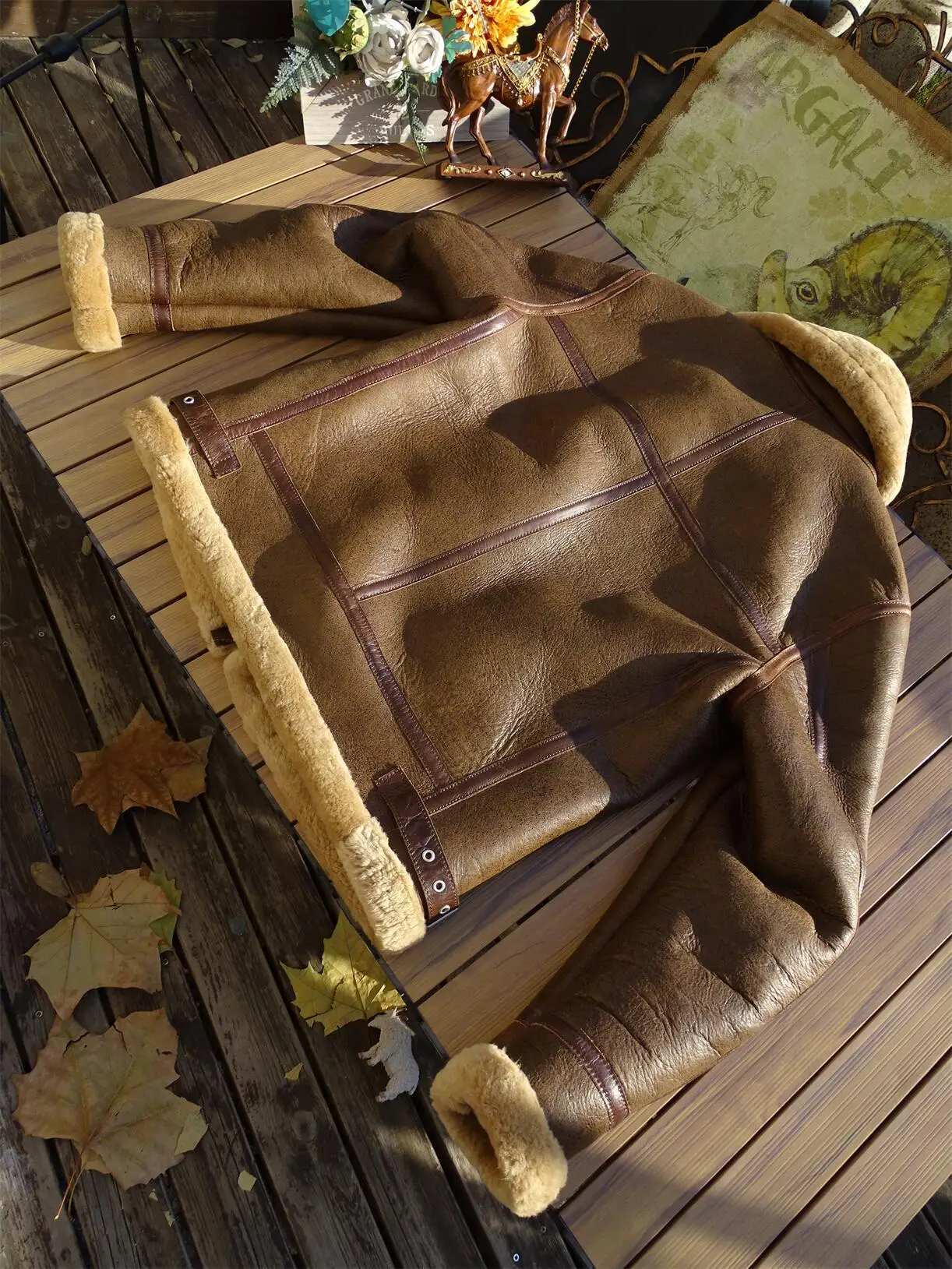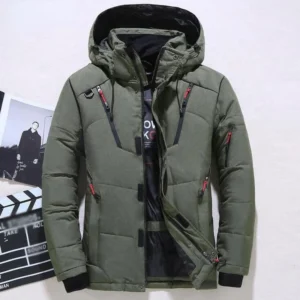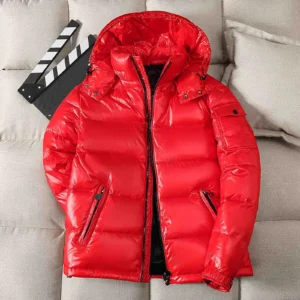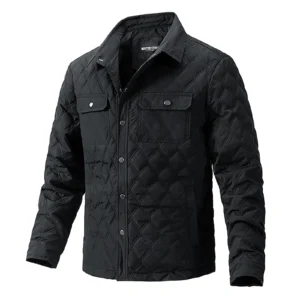Understanding Sheepskin: The Foundation Material
Sheepskin represents one of nature’s most versatile materials, serving as the foundation for many premium outerwear and accessories. In its most basic form, sheepskin refers to the hide of a sheep that has been processed through tanning. What makes sheepskin unique is its versatility—it can be processed with the wool still attached (wool-on) or with the wool removed to create a smooth leather surface.
The material’s quality varies significantly based on several key factors. Different sheep breeds produce distinctly different types of sheepskin, with Merino often considered among the finest due to its softer, denser wool. Geographic region also plays a crucial role—sheepskin from colder climates typically features denser wool for better natural insulation.
What makes sheepskin particularly valuable are its natural properties. The material offers exceptional insulation, maintaining body heat while simultaneously allowing moisture to escape. This breathability prevents overheating and keeps the wearer comfortable across various conditions. The natural lanolin present in sheepskin provides inherent water resistance and antimicrobial properties, while the material’s structure offers surprising durability despite its soft texture.
Traditional sheepskin processing involves careful preservation of these natural benefits while creating a stable, long-lasting material. The process includes cleaning, stretching, and treating the hide with natural tanning agents to prevent deterioration while maintaining flexibility. Many men’s sheepskin coats take advantage of these properties to create outerwear that’s both practical and luxurious.
The versatility of sheepskin makes it effective across numerous applications—from fashion and footwear to medical bedding and automotive accessories. This adaptability stems from sheepskin’s unique combination of durability and comfort, making it suitable for items that require both protection and softness. Understanding these fundamental aspects of sheepskin provides essential context for recognizing why sheepskin and shearling differ in significant ways, despite their common origin.
What Makes Shearling Special: A Premium Sheepskin Variant
Shearling stands apart as a distinct premium category within the broader sheepskin family. While all shearling is sheepskin, not all sheepskin qualifies as shearling—a distinction that explains much of the difference in quality, feel, and price between these materials.
True shearling comes specifically from young lambs, typically those that have been shorn only once. This origin is crucial to shearling’s exceptional softness and uniformity, as younger animals produce finer, more consistent wool fibers and more supple hides. The resulting material features a suede surface on one side and a clipped, plush wool surface on the other—creating a signature dual-texture material that defines authentic shearling.
The processing of shearling follows strict requirements that distinguish it from regular sheepskin. Unlike standard sheepskin, which can be processed in various ways, genuine shearling must be tanned with the wool still attached. This integrated approach creates a single piece where the wool remains permanently connected to the suede backing. The wool is then shorn to a uniform length (typically between 1/2 to 1 inch) to create a consistent, luxurious texture throughout the garment.
This specialized processing results in shearling’s characteristic appearance: one side displays a velvety suede finish while the other features a uniform, dense layer of soft wool. The natural connection between these layers creates superior insulation and comfort compared to materials where separate components are stitched together. Many men’s shearling coats showcase this distinctive dual-surface construction.
It’s worth noting that terminology can vary by region. In some markets, particularly in North America, “shearling” specifically denotes sheepskin where the wool has been shorn before processing, while in others, it refers to any tanned sheepskin with the wool attached. For consistency and clarity, this article uses the more widely accepted definition of shearling as the premium, double-sided material from young lambs with uniform wool length.
The unique properties of shearling create a material that’s distinctly different from standard sheepskin in both appearance and performance, making it important to understand the key differences between shearling and sheepskin when considering these materials for outerwear and other applications.
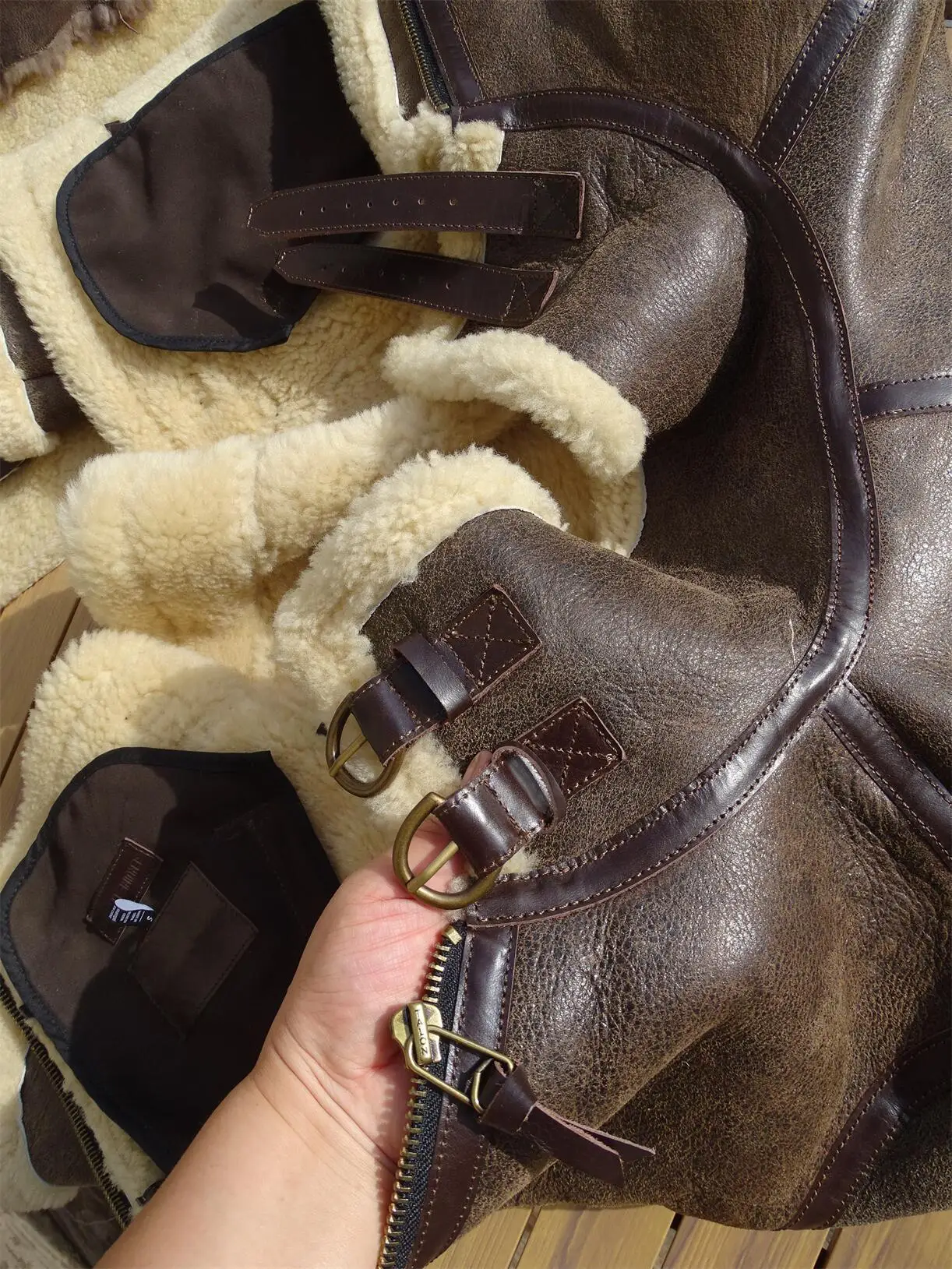
Source Differences: Animal Age and Selection
The age of the sheep represents one of the most fundamental differences between shearling and sheepskin, directly influencing the material’s quality and characteristics. Shearling comes exclusively from younger animals—typically lambs under one year old that have been shorn only once, if at all. In contrast, standard sheepskin can come from sheep of any age, including mature animals.
This age difference creates several important distinctions:
Fiber Diameter: Young lambs produce significantly finer wool fibers (often measuring 16-24 microns) compared to mature sheep (which can exceed 30 microns). This results in shearling’s noticeably softer, more luxurious feel.
Skin Texture: Younger animals have more supple, flexible hides with fewer imperfections. Mature sheep develop thicker, more rigid skin with more varied texture.
Natural Oils: Lamb skin contains higher concentrations of natural oils and lanolin, contributing to shearling’s buttery softness and natural sheen.
Breed selection also plays a crucial role in determining material quality. While both shearling and sheepskin can come from various sheep breeds, shearling typically utilizes breeds selected specifically for wool quality:
- Merino: Known for exceptionally fine, soft wool fibers
- Suffolk: Offers a good balance of wool density and hide strength
- Dorset: Produces consistent, uniform fleece suitable for premium applications
The selective breeding for specific characteristics results in shearling that exhibits remarkable consistency in texture and appearance. Standard sheepskin, while still high-quality, may show more variation in these properties depending on the source animal.
These source differences create the foundation for all subsequent variations in the materials. When examining a garment to determine whether it’s genuine shearling or sheepskin, these underlying source characteristics often provide the most reliable indicators of authenticity and quality.
Processing and Tanning Methods Compared
The journey from raw hide to finished material involves distinctly different processing paths for shearling versus standard sheepskin. These differences in treatment and preparation significantly impact the final product’s look, feel, and performance.
Shearling undergoes a specialized tanning process specifically designed to maintain the natural connection between wool and skin while enhancing both surfaces. The process typically follows these steps:
- Careful cleaning to preserve natural oils and wool integrity
- Precise trimming of wool to a uniform length (typically 1/2 to 1 inch)
- Chrome or vegetable tanning with specific agents that maintain wool attachment
- Sueding of the leather side to create a consistent velvety texture
- Conditioning of both surfaces to enhance softness and flexibility
By contrast, standard sheepskin processing varies based on the intended final product:
- Wool-on sheepskin follows similar initial steps but with less rigorous uniformity requirements
- Wool may be left at natural length or trimmed to varied specifications
- The leather side might be finished as suede, smooth leather, or with other textures
- Some sheepskin is processed with the wool completely removed, creating pure sheepskin leather
The chemical treatments also differ significantly. Premium shearling typically uses more refined, gentler tanning agents to preserve the delicate balance between the wool and skin layers. Standard sheepskin processing may employ more robust chemical treatments, particularly for products where durability takes precedence over softness.
These processing variations directly influence the material’s character. Shearling’s carefully controlled wool length creates its signature plush, even texture. The meticulous sueding of the opposite side produces the characteristic soft, velvety surface that distinguishes high-quality leather and shearling coats from other outerwear options.
Environmental considerations have also begun to influence processing methods, with more sustainable tanning approaches emerging for both materials. However, shearling’s more specialized processing requirements typically involve more steps and greater attention to detail, contributing to its premium status and higher cost.
Texture and Tactile Properties: The Feel Factor
The tactile experience of shearling versus sheepskin represents perhaps the most immediately noticeable difference between these materials. When you touch authentic shearling, you encounter a distinctly luxurious sensation that differentiates it from regular sheepskin.
Shearling offers an exceptionally consistent, velvety feel across its suede surface. This uniformity results from the careful processing of younger lamb hides, which naturally have fewer imperfections. The suede side feels remarkably soft and plush to the touch, with a fine nap that moves smoothly under the fingers in any direction. This consistent texture extends throughout the entire material without rough spots or irregularities.
The wool side of shearling presents an equally distinctive tactile experience. The fibers have been shorn to a uniform length, creating a dense, even cushion that feels cloud-like when compressed. The individual fibers are noticeably finer than in standard sheepskin, giving shearling its signature silky softness that feels gentle against bare skin.
In contrast, standard sheepskin can vary significantly in texture. The leather side may range from soft and pliable to more rigid and textured, depending on the animal’s age and the specific tanning process. The wool portion typically shows greater variation in density and fiber diameter, sometimes feeling coarser or less uniform than shearling’s carefully processed wool.
This difference in feel directly impacts comfort when worn against the skin. Shearling’s finer fibers and more consistent texture make it less likely to cause irritation, even for those with sensitive skin. The supple quality of the material also allows it to drape more elegantly around the body, creating a more refined silhouette than sometimes bulkier sheepskin.
The tactile properties of each material make them suitable for different applications. Shearling’s exceptional softness makes it ideal for items worn close to the skin or where comfort is paramount. Standard sheepskin’s more varied texture can provide advantages in applications where durability and texture variation are desirable aesthetic elements.
Thermal Properties: Warmth and Insulation Comparison
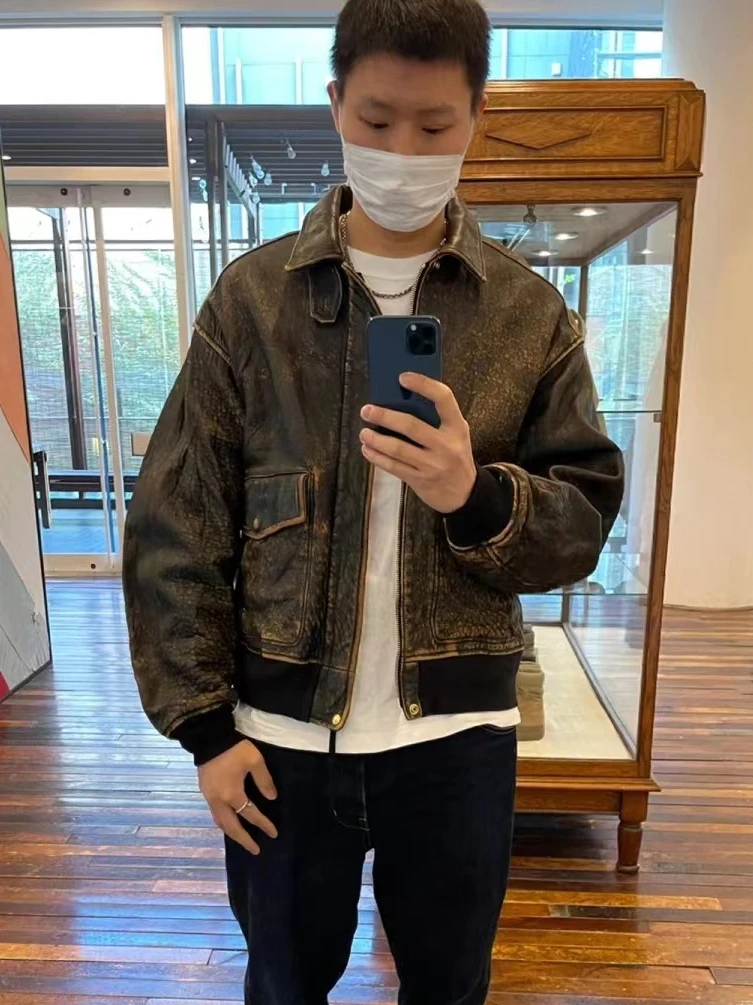
When it comes to providing warmth in cold conditions, both shearling and sheepskin excel, but with notable differences in how they deliver thermal protection. Understanding these distinctions helps explain why premium outerwear in each material performs differently in various weather conditions.
Shearling offers exceptional insulation through its dense, uniform wool fibers. The consistency in fiber length and distribution creates tiny air pockets throughout the material that trap body heat with remarkable efficiency. This structure provides outstanding warmth-to-weight performance, allowing shearling garments to deliver substantial thermal protection without excessive bulk. The natural crimp in lamb’s wool fibers enhances this effect by creating additional insulating air spaces.
Standard sheepskin also provides excellent insulation but through a slightly different mechanism. The typically longer and sometimes less uniform wool fibers create larger air pockets. This can provide substantial warmth but may require greater thickness to achieve the same insulating performance as premium shearling. The variation in wool density also means that thermal protection might be less consistent across the entire garment.
Both materials share impressive breathability characteristics that distinguish them from synthetic alternatives. Their natural fibers wick moisture away from the body while still maintaining insulation, preventing the clamminess that can occur with non-breathable insulators. However, shearling’s finer fibers typically provide superior moisture management, keeping the wearer more comfortable during temperature fluctuations or moderate activity.
The temperature regulation capabilities of these materials in extreme conditions highlight another key difference. Shearling maintains its insulating properties more effectively across a wider temperature range, making it particularly valuable for cold weather wear where temperatures fluctuate. The consistent density of the wool creates a more stable microclimate around the body.
This superior thermal efficiency explains why shearling commands premium pricing despite appearing similar to standard sheepskin at first glance. The material’s ability to provide exceptional warmth without bulk makes it particularly valuable for high-end outerwear that must balance thermal protection with elegant aesthetics.
Durability and Longevity Assessment
The investment value of both shearling and sheepskin largely depends on their durability and longevity, areas where these materials show meaningful differences despite their similar origins. These variations in wear resistance and aging characteristics significantly impact their long-term performance in various applications.
Shearling typically offers exceptional durability when properly maintained, with high-quality pieces often lasting decades. The suede exterior develops a beautiful patina over time rather than showing obvious wear, and the uniform wool interior maintains its plush texture through years of use. The material’s natural flexibility allows it to withstand repeated movement without cracking or becoming brittle at stress points.
Standard sheepskin demonstrates varying durability profiles depending on its specific processing:
- Wool-on sheepskin generally shows good longevity but may experience uneven wear in the wool portion, particularly in high-friction areas
- Sheepskin processed as leather without wool can develop excellent durability, sometimes exceeding shearling’s wear resistance for certain applications
- The connection between wool and hide layers in standard sheepskin may be more vulnerable to separation with age compared to properly processed shearling
Both materials show different vulnerability to environmental factors. Shearling’s suede exterior requires more protection from moisture compared to sheepskin finished as smooth leather. However, shearling often maintains its appearance better when exposed to sunlight, showing less fading and color change over time.
Common wear patterns also differ between these materials. Shearling typically shows initial wear through slight matting of wool fibers and minor scuffing on the suede surface. Standard sheepskin may experience more noticeable compression of wool in high-pressure areas and can develop a shinier, more polished appearance on leather surfaces with use.
With proper care, premium examples of both materials can serve as heirloom-quality pieces. Many winter coats made from these materials remain serviceable and attractive for generations, making them true investment pieces. However, shearling’s more consistent aging characteristics typically give it an edge in maintaining its luxurious appearance through years of regular use.
Weight and Comfort Analysis
The weight characteristics of shearling versus sheepskin represent another significant practical difference that impacts the wearing experience. These variations in weight and density directly influence comfort during extended wear, especially for outerwear pieces.
Shearling typically offers a superior weight-to-warmth ratio compared to standard sheepskin. A properly processed shearling garment delivers exceptional insulation while maintaining a relatively light feel. This efficiency stems from the material’s uniform structure and the natural insulating properties of fine lamb’s wool fibers. The consistent density throughout the material creates even weight distribution that feels balanced when worn.
Standard sheepskin, particularly varieties with longer or less uniform wool, often weighs more for comparable warmth. The additional bulk can make sheepskin garments feel heavier, especially after extended wear. However, this extra substance sometimes provides advantages in extremely cold or windy conditions where maximum protection takes precedence over lightweight comfort.
The flexibility of these materials also differs noticeably. Shearling’s natural suppleness allows it to move more freely with the body, creating less restriction during active wear. The material drapes more elegantly and conforms better to the wearer’s silhouette. Standard sheepskin, while still flexible, typically requires more breaking in and may maintain a slightly stiffer hand throughout its lifespan.
These weight and flexibility characteristics directly impact the comfort experience in different contexts. For daily urban wear where movement and comfort balance with protection, shearling’s advantages make it a popular luxury outerwear choice. For extreme conditions where maximum insulation matters most, the slightly heavier construction of some sheepskin varieties might be preferred.
Considering weight when selecting between these materials helps ensure the final choice meets both practical needs and comfort expectations. The seemingly subtle difference in density and flexibility becomes increasingly apparent during all-day wear, making it an important factor in the overall value assessment of these premium materials.
Moisture Resistance and Weather Performance
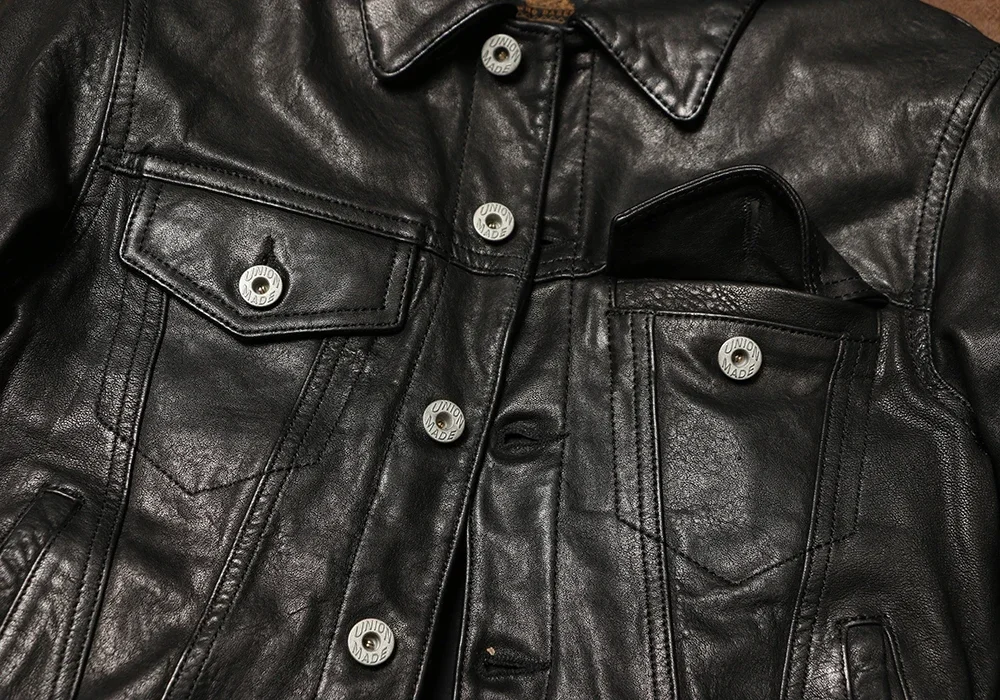
How shearling and sheepskin interact with moisture represents one of the most practical differences between these materials, particularly for outerwear designed for variable weather conditions. Their distinct approaches to handling water exposure significantly impact their performance and care requirements.
Natural lanolin content provides both materials with some inherent water resistance. However, significant differences exist in how effectively they repel moisture and maintain insulation when wet:
Shearling typically contains higher natural lanolin levels due to its origin from younger animals. This provides good initial water resistance, with light moisture beading up on the suede surface before penetration. However, the suede exterior can become vulnerable once this natural protection is overwhelmed. Extended exposure can allow moisture to penetrate the suede and potentially reach the wool layer, though the wool continues to insulate even when damp.
Standard sheepskin processed as smooth leather often demonstrates superior water resistance compared to shearling’s suede exterior. The smoother surface allows water to run off more effectively, and additional water-resistant treatments adhere better to this finish. However, if water does penetrate the leather layer, the less dense wool may become more thoroughly saturated.
Performance across different weather conditions highlights additional distinctions:
Snow: Both materials perform admirably in dry snow conditions. Shearling’s superior insulation gives it an advantage in extreme cold, while some sheepskin finishes better repel melting snow.
Rain: Neither material is naturally waterproof, but sheepskin with a smooth leather finish typically handles moderate rain better than shearling’s more absorbent suede exterior.
Wind: Both offer excellent wind protection, with properly constructed garments creating an effective barrier against cold air. Shearling’s more consistent density may provide slightly better performance in high-wind conditions.
Humidity: Both materials breathe well in high humidity, though shearling’s finer fibers generally wick moisture more effectively, maintaining comfort in damp conditions.
These performance characteristics make each material suitable for specific winter wear applications. Shearling excels in very cold, relatively dry conditions where its superior insulation and breathability shine. Standard sheepskin, particularly with water-resistant treatments, may perform better in wetter environments where moisture management takes priority over maximum insulation.
Mens Heavy Winter Coat, Mens Insulated Coat, Mens Parka Coat
Price range: $175.52 through $237.36 Select options This product has multiple variants. The options may be chosen on the product pageMens Big and Tall Winter Coats, Mens Down Coat, Mens Hooded Winter Coat, Mens Puffer Coat
Price range: $126.44 through $217.01 Select options This product has multiple variants. The options may be chosen on the product pageMens Big and Tall Winter Coats, Mens Hooded Winter Coat
Price range: $80.32 through $106.68 Select options This product has multiple variants. The options may be chosen on the product pageMens Cashmere Overcoat, Mens Hooded Winter Coat, Mens Wool Blend Coat
Price range: $128.72 through $139.68 Select options This product has multiple variants. The options may be chosen on the product pageMens Hooded Winter Coat, Mens Insulated Coat, Mens Puffer Coat, Mens Quilted Coat
Price range: $139.88 through $177.72 Select options This product has multiple variants. The options may be chosen on the product pageMens Double Breasted Pea Coat, Mens Hooded Winter Coat, Mens Quilted Coat
Price range: $81.00 through $108.48 Select options This product has multiple variants. The options may be chosen on the product page
Price Comparison and Value Assessment
The notable price differential between shearling and sheepskin reflects genuine differences in sourcing, processing, and resulting quality. Understanding these factors helps explain why premium shearling commands higher prices and whether that investment delivers proportional value.
Shearling consistently positions at the higher end of the price spectrum, often costing 30-50% more than comparable sheepskin products. This premium pricing stems from several key factors:
Selective Sourcing: Shearling’s requirement for younger animals from specific breeds limits supply and increases raw material costs.
Processing Complexity: The specialized tanning and finishing procedures for authentic shearling involve more steps and greater expertise.
Uniformity Requirements: Achieving shearling’s consistent texture and appearance requires more selective raw material grading and more careful processing.
Limited Production: Many premium shearling items involve more hand-crafting and smaller production runs, increasing labor costs.
Standard sheepskin offers more price variation based on specific types and quality levels. Basic sheepskin products represent a more accessible price point, while high-end sheepskin still commands premium pricing but typically remains below comparable shearling items.
The value equation extends beyond initial cost to consider longevity and performance. Shearling’s superior durability often means a longer useful lifespan, potentially offering better cost-per-wear despite the higher initial investment. Its exceptional insulation efficiency also provides functional benefits that may justify the premium for those in particularly cold environments.
Aesthetic considerations also factor into the value assessment. Shearling’s more refined appearance and elegant drape create a distinctly luxurious look that many find worth the additional investment. The material’s ability to develop character while maintaining its essential properties through years of wear adds to its appeal as an investment piece.
For those considering this purchase decision, classic shearling jackets for men represent a significant investment that balances immediate costs against long-term benefits. The decision ultimately depends on individual priorities—whether maximum warmth, refined aesthetics, or longest potential lifespan carries the most weight in the personal value equation.
Applications: Ideal Uses for Each Material
The distinct properties of shearling and sheepskin make each material particularly well-suited for specific applications. Understanding these ideal use cases helps match the right material to individual needs and preferences.
Shearling excels in applications requiring:
Premium Outerwear: The material’s exceptional warmth-to-weight ratio and refined appearance make it ideal for high-end jackets and coats where both performance and aesthetics matter.
Aviation and Performance Wear: Shearling’s superior insulation without bulk makes it perfect for flight jackets and other performance outerwear where movement and comfort must balance with protection.
Luxury Accessories: Items worn close to sensitive skin benefit from shearling’s remarkably soft texture, making it ideal for premium gloves, collars, and other accessories.
High-End Footwear: Premium boots and slippers utilize shearling’s combination of insulation, moisture management, and comfort against bare feet.
Standard sheepskin shows its strengths in:
Rugged Outdoor Applications: The material’s durability and more substantial feel make it excellent for outdoor work wear and activities where abrasion resistance matters.
Home Goods: Sheepskin rugs, seat covers, and bedding benefit from the material’s plush comfort and durability under regular use.
Medical Applications: Pressure-relieving pads and supports utilize sheepskin’s pressure distribution properties for patient comfort.
Mid-Range Outerwear: Sheepskin offers excellent value in everyday winter coats where maximum refinement isn’t the primary concern.
The material choice often depends on the specific balance of factors relevant to each application. For severe winter conditions where warmth is the absolute priority, both materials perform admirably, but shearling’s efficiency might make it preferable for winter outerwear decisions.
Fashion applications often favor shearling for its more elegant drape and refined texture, while rugged outdoor uses may benefit from certain sheepskin varieties’ robust character. Understanding these ideal applications helps direct the material choice toward options that will provide the best performance for specific needs.
Quick Reference Comparison Chart
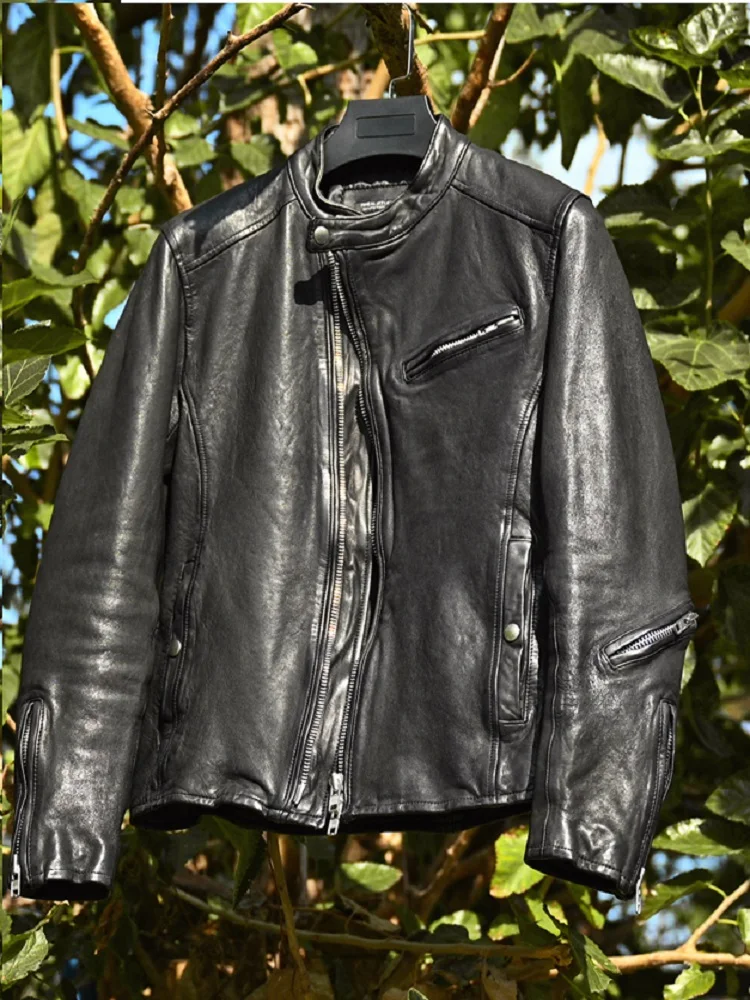
| Characteristic | Shearling | Sheepskin |
|---|---|---|
| Source | Young lambs (typically under 1 year) | Sheep of any age |
| Processing | Tanned with wool attached, uniform wool length | Various processing methods (wool-on or wool-off) |
| Texture | Consistent suede exterior, uniform plush wool interior | Variable texture; may be smooth leather or suede exterior |
| Wool Quality | Fine, soft, uniform fibers (16-24 microns) | Variable fiber diameter (can exceed 30 microns) |
| Insulation | Superior warmth-to-weight ratio, very efficient | Excellent insulation but may require more bulk |
| Weight | Lighter for comparable warmth | Often heavier/bulkier for similar insulation |
| Water Resistance | Good initial resistance but suede vulnerable to saturation | Varies; smooth leather finish offers better water resistance |
| Durability | Excellent longevity with proper care; ages gracefully | Good durability; varies by specific processing |
| Flexibility | Very supple, excellent drape and movement | Generally good but may be slightly stiffer |
| Price | Premium pricing (30-50% higher than comparable sheepskin) | More accessible with wider price range |
| Ideal Applications | Luxury outerwear, aviation jackets, premium accessories | Diverse uses from outerwear to home goods and medical |
Making the Right Choice: Decision Factors
Selecting between shearling and sheepskin involves weighing several key factors against your specific needs and preferences. This framework helps navigate that decision process to find the optimal material for your situation.
Climate considerations should significantly influence your choice:
* For extremely cold, dry environments, shearling’s superior insulation efficiency makes it an excellent choice
* For moderately cold regions with higher precipitation, certain sheepskin finishes may offer better moisture management
* For variable conditions, shearling’s broader performance range across temperatures often provides an advantage
Intended use creates another important decision dimension:
* Daily urban wear benefits from shearling’s lighter weight and refined appearance
* Outdoor work or rugged applications might favor certain sheepskin varieties’ durability
* Special occasions might justify shearling’s premium aesthetics and comfort
Care commitment should honestly assess your willingness to maintain the material:
* Shearling’s suede exterior typically requires more careful protection from heavy moisture
* Some sheepskin finishes offer easier maintenance with more forgiveness for occasional neglect
* Both materials benefit from proper storage and periodic professional cleaning
Style preferences naturally play a significant role:
* Shearling’s more refined texture and elegant drape create a distinctly luxurious aesthetic
* Certain sheepskin varieties offer a more rugged, substantial appearance that some prefer
* Consider which material better complements your existing wardrobe and personal style
The investment horizon also matters—those planning to use the item for many years might find shearling’s exceptional longevity justifies its premium price, while shorter-term needs might be well-served by quality sheepskin at a more moderate price point.
For those specifically focused on cold weather protection, both materials offer excellent performance, but the specific balance of insulation, weight, and moisture management should align with your typical winter conditions and activities.
Care and Maintenance: Preserving Your Investment
Proper care significantly extends the lifespan of both shearling and sheepskin, though each material has specific maintenance requirements to maintain its distinctive qualities. Following appropriate care protocols ensures these premium materials continue performing and looking their best for years.
For shearling care, follow these essential practices:
* Brush the wool interior regularly with a soft-bristled brush to maintain loft and remove debris
* Clean the suede exterior by gently brushing with a suede brush in one direction
* Address spills immediately by blotting (never rubbing) with a clean, absorbent cloth
* Avoid direct heat sources when drying, as excessive heat can cause shrinkage or hardening
* Store on padded hangers in breathable garment bags, away from direct sunlight
Standard sheepskin requires similar but slightly different approaches:
* Clean according to the specific finish—smooth leather requires different care than suede exteriors
* Treat wool portions similarly to shearling, with regular gentle brushing
* Some sheepskin finishes may accept specialized conditioners that would be inappropriate for shearling
* Store with similar considerations for air circulation and protection from direct light
Both materials benefit from these preventative measures:
* Avoid wearing during heavy precipitation without appropriate protection
* Allow to dry naturally and completely if exposed to moisture
* Rotate items regularly to prevent excessive wear in specific areas
* Consider professional cleaning annually for items worn frequently
* Apply appropriate protectant products designed specifically for these materials
Common care mistakes to avoid:
* Never machine wash or dry clean unless the item specifically indicates it’s safe
* Avoid standard leather conditioners on suede surfaces
* Don’t use wool cleaners designed for textiles on attached wool portions
* Never store in plastic bags, which trap moisture and can cause mildew
For comprehensive guidance on maintaining all leather outerwear, including these specialized materials, understanding proper leather coat care and maintenance can significantly extend their useful life. The initial investment in quality shearling or sheepskin becomes even more valuable when proper care preserves its appearance and performance over many years.
Environmental and Ethical Considerations
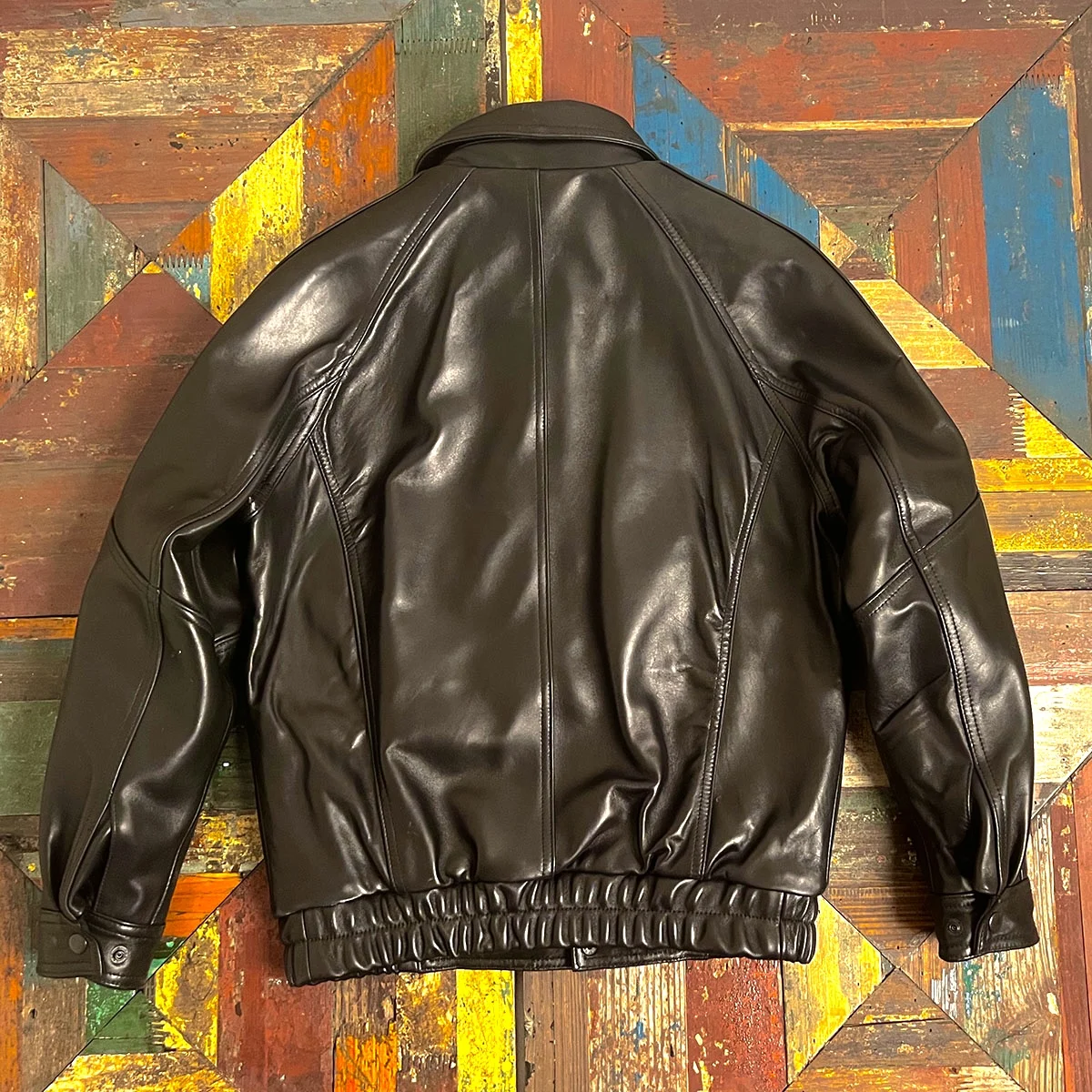
The environmental and ethical dimensions of shearling and sheepskin production deserve careful consideration, as both materials come from animal sources. Understanding these aspects helps consumers make choices aligned with their personal values.
Both shearling and sheepskin are primarily byproducts of the meat production industry, particularly in major producing regions like Australia, New Zealand, and parts of Europe. This relationship means that in most cases, the hides are utilized from animals already raised for food production, rather than specifically for their pelts. This integration with food systems represents a more sustainable approach compared to materials produced solely for fashion.
Processing methods create environmental distinctions between materials. Traditional tanning involves chemicals that can impact water systems if not properly managed. However, modern processing facilities increasingly implement:
- Closed-loop water systems that recycle and treat water
- Vegetable tanning methods that use plant-based compounds instead of chromium
- Energy-efficient production that reduces carbon footprint
Ethical sourcing has become increasingly important in premium markets. Better producers for both materials now emphasize:
- Animal welfare standards during raising and processing
- Traceability systems that document sourcing back to specific farms
- Compliance with international standards for humane treatment
For consumers concerned about these issues, certifications provide guidance. Look for:
- Responsible Wool Standard (RWS) certification
- Leather Working Group (LWG) rated producers
- Farm-specific sourcing information when available
Some consumers may prefer synthetic alternatives for ethical reasons. However, it’s worth noting that premium natural materials like shearling and sheepskin typically last significantly longer than synthetic alternatives, potentially creating less environmental impact over their complete lifecycle despite their animal origin.
The question of whether shearling represents a more ethical choice than traditional fur involves different considerations, including the byproduct nature of shearling versus the primary-purpose harvesting of many fur-bearing animals. Understanding these nuances helps consumers make choices aligned with both their practical needs and personal values.
Frequently Asked Questions About Shearling vs. Sheepskin
Is shearling just another name for sheepskin?
No, though they’re related. Shearling specifically refers to sheepskin from young lambs that has been processed with the wool attached and shorn to a uniform length. It features a suede exterior and a plush wool interior. While all shearling is sheepskin, not all sheepskin qualifies as shearling.
Which material provides better warmth for extreme cold?
Shearling typically offers superior insulation efficiency for extreme cold. Its denser, more uniform wool fibers create more consistent warmth with less bulk. Standard sheepskin provides excellent insulation but may require greater thickness to achieve comparable warmth. For the most challenging winter conditions, both materials perform well, but shearling’s warmth-to-weight ratio gives it an advantage for winter wear.
How can I identify authentic shearling vs. regular sheepskin?
Authentic shearling features a suede exterior paired with a plush, uniform wool interior where fibers are consistently shorn to the same length. The material should feel exceptionally soft, with the wool firmly attached to the hide. Regular sheepskin may have more variation in wool length and density. The leather might be finished as suede or smooth leather, and the overall material often feels more substantial.
Is shearling worth the higher price compared to sheepskin?
For many users, yes. Shearling’s premium price reflects its more selective sourcing, specialized processing, and superior performance characteristics. The material typically offers better insulation efficiency, lighter weight, more refined aesthetics, and exceptional longevity. For those who prioritize these qualities and plan long-term use, the investment often proves worthwhile through years of superior performance and comfort.
Can either material be worn in wet conditions?
Neither material is naturally waterproof, though both have some inherent water resistance from natural lanolin. Sheepskin with a smooth leather finish generally handles wet conditions better than shearling’s more absorbent suede exterior. Both can be treated with appropriate protective products to enhance water resistance, but extended exposure to heavy precipitation should be avoided without proper protection.
Authenticating Real vs. Faux Materials
With synthetic alternatives becoming increasingly sophisticated, distinguishing authentic shearling and sheepskin from imitations requires knowledge of key indicators. These practical identification methods help ensure you’re getting genuine materials when investing in premium products.
Visual inspection provides the first line of authentication:
* Genuine materials show natural variation in the grain pattern across the suede or leather surface
* Real wool fibers have a slight crimp or wave when examined closely, while synthetic fibers appear straighter
* Authentic materials have subtle color variations rather than perfectly uniform coloring
Tactile assessment offers even more definitive evidence:
* Real wool feels warm to the touch almost immediately and becomes warmer as you continue touching it
* Synthetic materials feel cooler initially and don’t develop warmth as quickly
* Genuine suede has a distinct nap that changes appearance when brushed in different directions
* The wool should be firmly attached to the hide without separating easily
The burn test, while not practical in retail settings, provides definitive proof for items you already own:
* A small, discreet fiber sample from real wool will smell like burning hair and create ash that crumbles easily
* Synthetic fibers melt rather than burn and produce a chemical odor
Common imitation techniques to be aware of include:
* “Sherpa” or “faux shearling” materials using synthetic pile attached to backing material
* Split leather with synthetic wool glued to one surface
* Completely synthetic materials designed to mimic both suede and wool textures
Price offers another reality check—authentic shearling and premium sheepskin command significant prices. Items priced suspiciously below market averages likely use synthetic alternatives or lower-quality materials. While some synthetic options provide decent performance at lower price points, they typically lack the longevity, breathability, and temperature regulation of genuine materials.
Global Variations in Terminology and Quality
Regional differences in terminology, production techniques, and quality standards create an additional layer of complexity when comparing shearling and sheepskin globally. Understanding these variations helps navigate international products and descriptions.
In North America, “shearling” specifically refers to sheepskin where the wool has been shorn once before or after processing. However, in European markets, particularly the UK, the term may be applied more broadly to any sheepskin with wool attached. This terminology difference can create confusion when comparing products from different regions.
Quality standards also vary significantly by production region:
Australia/New Zealand: Known for exceptionally high-quality merino sheepskin with fine, dense wool. These regions produce some of the world’s premium materials with consistent grading standards.
European Production: Countries like Spain, Italy, and Turkey have long traditions of specialized processing that create distinctive regional variations, particularly in tanning techniques that influence the material’s hand and finish.
North American Processing: Often focuses on rugged, durable finishes for outdoor and work applications, with specific standards for thickness and wear resistance.
Notable regional specialties include Spanish merino shearling, prized for its exceptionally fine wool, and Icelandic sheepskin, known for its distinctive long, shaggy wool texture. Turkish production often emphasizes rich color development in the leather portion, while Italian tanneries may focus on creating exceptionally supple hand and elegant drape.
These regional variations extend beyond terminology to actual material characteristics. Different production regions may emphasize specific qualities—dense insulation, smooth texture, or distinctive appearance—based on local preferences and traditional techniques.
When shopping internationally, understanding these regional variations helps interpret product descriptions accurately and assess whether a specific regional specialty might better suit your particular needs than a more generic offering. These global differences contribute to the rich diversity of options available within the broader categories of shearling and sheepskin.

